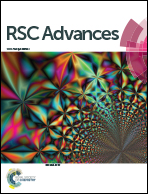Step-feed strategy enhances performance of unbuffered air-cathode microbial fuel cells†
Abstract
Step-feed anolyte recirculation is compared with single-inlet recirculation feed in a single-chamber air-cathode microbial fuel cell (MFC) under buffer-less conditions, to examine the effects of distributing the organic load and cathodically increased electrolyte pH across the anode. The step-feed effects on proton transfer, maximum power output, and chemical oxygen demand removal are investigated. The results show that better proton transfer could be induced by using a step-feed configuration with uniform flow distribution across four anode sections of MFCs. Thus, the maximal power density is increased from 3.5 W m−3 to 4.12 W m−3, indicating a 17.7% increase in the maximum power density. A slight increase (9.9%) is obtained in coulombic efficiency (CE, 11.1%). Additional 5.1% increases in power (4.33 W m−3) and 15% increases in CE (approximately 12.5%) are observed after increasing the flow distribution toward the anode section closest to the cathode. This study demonstrates that step-feed could be a beneficial operational strategy for future MFC designs.



 Please wait while we load your content...
Please wait while we load your content...